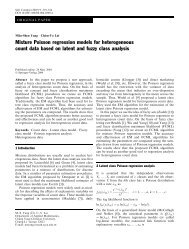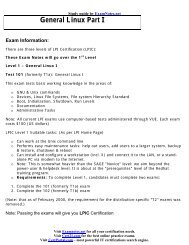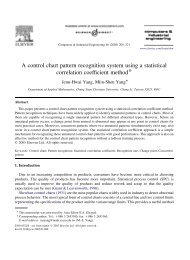A novel fuzzy clustering algorithm based on a fuzzy scatter matrix ...
A novel fuzzy clustering algorithm based on a fuzzy scatter matrix ...
A novel fuzzy clustering algorithm based on a fuzzy scatter matrix ...
Create successful ePaper yourself
Turn your PDF publications into a flip-book with our unique Google optimized e-Paper software.
K.-L. Wu et al. / Pattern Recogniti<strong>on</strong> Letters 26 (2005) 639–652 651<br />
0.5<br />
m=1.5<br />
0.12<br />
m=2<br />
NFI<br />
0.4<br />
PIM<br />
NFI<br />
0.10<br />
0.08<br />
0.06<br />
FCS<br />
0.04<br />
0.3<br />
FCS<br />
0.02<br />
PIM<br />
0.00<br />
0 0.05 0.1 0.15 0.2 0.5 0.99<br />
beta, delta<br />
(a)<br />
0 0.05 0.1 0.15 0.2 0.5 0.99<br />
beta, delta<br />
(b)<br />
Fig. 8. NFI(11) values for the normalized Vowel data set in which both PIMand FCS <str<strong>on</strong>g>algorithm</str<strong>on</strong>g>s are processed with the same<br />
parameter values.<br />
nels can avoid the situati<strong>on</strong> in which the sample<br />
mean is a unique optimizer of the FCS objective<br />
functi<strong>on</strong>. Fig. 7 presents the NFI (2) values of<br />
the data set shown in Fig. 5. The NFI values of<br />
FCS with cluster kernels (b > 0) are always larger<br />
than the NFI values of the FCM(b = 0) which is<br />
the case of the sample mean x being the unique<br />
optimizer with NFI = 0 when m = 10 and 20. This<br />
shows that the FCS <str<strong>on</strong>g>algorithm</str<strong>on</strong>g> can avoid the case<br />
of NFI = 0 and is robust to the noise and outliers<br />
than FCMwhen m is larger. Because the sample<br />
mean x of the data set shown in Fig. 6 will not<br />
be the unique optimizer of FCMand FCS when<br />
m is larger, we do not show their NFI values.<br />
Note that some properties of FCS discussed<br />
above can also be achieved by the partiti<strong>on</strong> index<br />
maximizati<strong>on</strong> (PIM) <str<strong>on</strong>g>algorithm</str<strong>on</strong>g> (Özdemir and<br />
Akarun, 2002) which used a fixed volume for all<br />
cluster kernels. The radius of each cluster volume<br />
in PIMis defined by<br />
a ¼ d minfmin ka i a 0<br />
i6¼i 0 ik=2g; 0 6 d 6 1: ð34Þ<br />
The NFI values of the normalized Vowel data set<br />
in the UCI Machine Learning Repository (Blake<br />
and Merz, 1998) of PIMand FCS are shown in<br />
Fig. 8. Yu et al. (2004) showed that when<br />
m > 1.7787, the sample mean x will be the unique<br />
optimizer of FCMfor the normalized Vowel data<br />
set in Blake and Merz (1998). InFig. 8(a), when<br />
m = 1.5, both PIMand FCS with different d and<br />
b values have the NFI index values larger than<br />
0.3. However, when m = 2 as shown in Fig. 8(b),<br />
the PIMgive the same NFI values as FCM<br />
(d =0 or b = 0). The use of the same volumes of<br />
the cluster kernels do not help PIMto have a larger<br />
NFI values than FCM. The same situati<strong>on</strong><br />
when m = 2 in FCS as shown in Fig. 8(b), the<br />
NFI values of FCS are always larger than FCM<br />
and PIM. Using the different cluster kernel volumes<br />
in FCS produces these good merits.<br />
7. C<strong>on</strong>clusi<strong>on</strong>s<br />
We proposed a <str<strong>on</strong>g>novel</str<strong>on</strong>g> <str<strong>on</strong>g>clustering</str<strong>on</strong>g> <str<strong>on</strong>g>algorithm</str<strong>on</strong>g><br />
called the FCS <str<strong>on</strong>g>algorithm</str<strong>on</strong>g> which attempts to minimize<br />
the <str<strong>on</strong>g>fuzzy</str<strong>on</strong>g> within-cluster <strong>scatter</strong> <strong>matrix</strong> trace<br />
and simultaneously maximize the <str<strong>on</strong>g>fuzzy</str<strong>on</strong>g> betweencluster<br />
<strong>scatter</strong> <strong>matrix</strong> trace. Each cluster obtained<br />
by the FCS will have a cluster kernel. Data points<br />
that fall inside any <strong>on</strong>e of the c cluster kernels will<br />
have crisp memberships and be outside all of the<br />
cluster kernels that have <str<strong>on</strong>g>fuzzy</str<strong>on</strong>g> memberships.<br />
The volume of each cluster kernel is decided by<br />
the parameter g i which is a functi<strong>on</strong> of b. The crisp<br />
and <str<strong>on</strong>g>fuzzy</str<strong>on</strong>g> memberships co-exist in the FCS. The<br />
cluster center update equati<strong>on</strong>s in the FCS can<br />
be interpreted as a weighted mean of the FCM<br />
cluster centers and the grand mean x. Numerical<br />
examples show that the FCS can have more accurate<br />
results in the parameter estimati<strong>on</strong> than the<br />
FCM. It also shows that FCS can help avoid the<br />
situati<strong>on</strong> where the sample mean x is a unique<br />
optimizer of FCMand is more robust to noise







